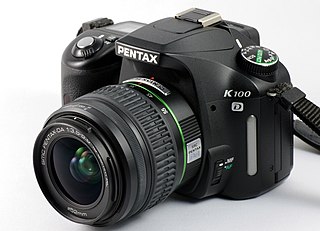 W
WThe EOS 400D, called Digital Rebel XTi in North America and EOS Kiss Digital X in Japan, is an entry-level digital single-lens reflex camera introduced by Canon on 24 August 2006.
 W
WThe Flip Video cameras are an American series of tapeless camcorders for digital video created by Pure Digital Technologies, a company bought by Cisco Systems in March 2009; variants included the UltraHD, the MinoHD, and the SlideHD. Flip Video cameras were known for their simple interface with few buttons, minimal menus and built in USB plugs, and were marketed as making video "simple to shoot, simple to share" Production of the line of Flip video cameras ran from 2006 until April 2011, when Cisco Systems discontinued them as part of a move to "...exit aspects of (their) consumer businesses." Flip cameras contributed to an increase in the popularity of similar pocket camcorders, although the inclusion of HD video cameras in many smartphones has since made them a more niche product.
 W
WThe Fujifilm FinePix S6500fd, known in the United States as S6000fd, was the first digital camera from Fujifilm with face detection technology. Also this camera has a different lens from its recent predecessors — a 28–300 mm equivalent 10.7x zoom, the same as the FinePix S9100/9600. The camera was announced on July 13, 2006.
 W
WThe Leica M8 is the first digital camera in the rangefinder M series introduced by Leica Camera AG on 14 September 2006. It uses an APS-H 10.3-megapixel Kodak KAF-10500 CCD image sensor.
 W
WThe Nikon D40 is Nikon F-mount entry-level digital SLR, announced November 16, 2006 and made until March 2009, when it was succeeded by the Nikon D3000. Compared to its predecessor, the D50, the D40 had several features removed, a few added, and a lower price: US$499.95 ESP as of November 2009 with the 18–55 mm G-II kit lens, positioning it as an entry-level model compared to the D80. The D40x has a 10-megapixel maximum resolution, up from 6 megapixels of the D40 and D50.
 W
WThe Nikon D80 is a digital single-lens reflex camera model announced by Nikon on August 9, 2006. The camera shipped the first week of September to US retailers. Considered by many to be a hybrid of design elements of the entry-level D50 and high-end D200 cameras, it occupied the same price bracket the Nikon D70 did at the time of its release. It was replaced by the Nikon D90 in August 2008.
 W
WThe Olympus μ("mju") 700 — also known as the Olympus Stylus 710 in North America — is a 7.1 megapixel ultra-compact digital camera introduced by Olympus Corporation in 2006.
 W
WThe Olympus SP-510UZ is a 7.1-megapixel bridge digital camera introduced by Olympus Corporation in 2006. It replaced the 6 megapixel SP-500UZ model that was launched in 2005. It was the last model of the SP-series that used a 10x optical zoom lens. It was also the last of the larger-sized 10x optical ultra zoom cameras to be made by Olympus, which had been part of the C-series before the SP-series was produced. The SP-510UZ model can be traced back to the C-2100 Ultra Zoom, which was launched back in 2000. The successor model to the SP-510UZ was the SP-550UZ. It used a longer 18x optical zoom lens. Today, the newest model in the Ultra Zoom camera line, the SP-590UZ, features a 26x optical zoom lens. In 2009, Olympus released a compact camera with a 10x optical zoom lens. However, it does not use the Ultra Zoom name nor is it a part of the SP-series line of cameras.
 W
WThe Panasonic Lumix DMC-FZ7 is a six megapixel superzoom bridge digital camera that utilizes Panasonic's Venus II Engine. It features a 12× zoom lens and several modes of operation. It was replaced in 2007 by the DMC-FZ8
 W
WThe Pentax K10D and similar Samsung GX-10 are 10.2 megapixel digital single-lens reflex cameras launched in late 2006. They were developed in a collaboration between Pentax of Japan and Samsung of South Korea.
 W
WThe Pentax K100D and similar Pentax K110D are 6 megapixel digital single-lens reflex cameras, launched in the U.S. on May 22, 2006. The K100D has a maximum resolution of 3008 x 2008, and can also down-sample to 2400 x 1600 and 1536 x 1024. The slowest metered shutter speed is 30 seconds and the fastest shutter is 1/4000 seconds.
 W
WSony α, is a camera system introduced on 5 June 2006. It uses and expands upon Konica Minolta camera technologies, including the Minolta AF SLR lens mount, whose assets were acquired by Sony after the end of Konica Minolta's photography operations in early 2006. Sony also has an 11.08% ownership stake in Japanese lens manufacturer Tamron, which is known to have partnered with Konica Minolta and Sony in the design and manufacture of many zoom lenses.